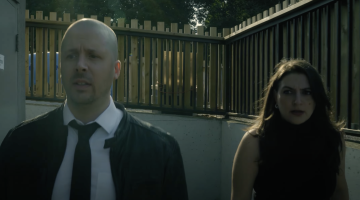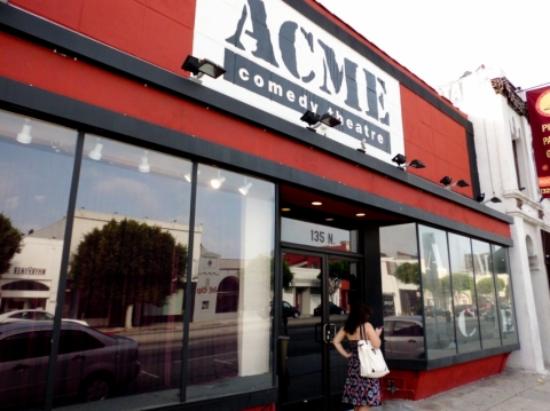 Welcome back, everyone, to Brewing Up On The Rocks. In this fifth installment of the series, we’ll look at the production of the pilot episode and explore the business side of launching a web series. Do you know how to find the best theater for your needs, or how to handle the taxes for the money raised with a crowd funding campaign? Stay tuned for the answers.
Welcome back, everyone, to Brewing Up On The Rocks. In this fifth installment of the series, we’ll look at the production of the pilot episode and explore the business side of launching a web series. Do you know how to find the best theater for your needs, or how to handle the taxes for the money raised with a crowd funding campaign? Stay tuned for the answers.
Theaters, Theaters Everywhere
So, the staff is assembled, the pilot is written and the cast is in place now we just have to film the damn thing. You might think shooting a multicam show is simple. After all, there is usually just one location and you don’t have to deal with external factors like weather or street noise. Just find a theater, setup the stage and shoot it. If only it were that easy.
“Shooting a multicam series has some advantages, but it also presents some challenges for production,” said Violet Ket, a writer/producer for On The Rocks. “One of these was finding the right stage for our size production.”
Multicam shows require a large stage, especially if they are shot in front of an audience. A typical Black Box theater isn’t big enough for four cameras, six actors and all the set decoration.
To find the right place Kett and show runner, Sam Miller, used a combination of recommendations, independent research, listing posted at http://spacefinderla.org and cold-calling. They checked out theaters from Santa Monica to Eagle Rock to find a place that was priced right and had was set up for a mulitcam shoot.
“We had originally decided on a stage which was the right size for our needs. It was at a great location in Hollywood,” said Ket. “But then the Hollywood Fringe Festival was about to start and the stage we had selected was booked.”
The search eventually led to the ACME Theater in Hollywood. It was a little more than the budget called for, but it turned out to be the ideal choice.
“ACME had a stage that already had something of an interior look and it provided some options to help facilitate production,” said Miller. “They had sound and lighting equipment in place, plus camera operators. They were able to function as a mini television production studio.”

Kett was also impressed with ACME’s setup and saw the advantage of using not only their stage, but some of their personnel, too.
“We didn’t even need to source our production staff as we could hire them directly through the theater,” said Kett. “Additionally, ACME was gracious enough to let us use their sets and props, which was a major help as we were scrambling to meet our production deadlines.”
From Page to Stage
With the theater secured, it was time to shift into full on production mode. Production designer, Fernando Marroquin was brought on board as was Ed Brown, an experienced TV director.
Miller knew Brown through his work on Gary Unmarried, a multicam CBS sitcom starring Jay Mohr that aired from 2008 to 2010. He was also a staff writer for Rodney an ABC multicam starring standup comedian Rodney Carrtington that aired from 2004 to 2006.
“When we got a really good cast, we wanted the experience to be as professional as possible so I wanted a director with network and live audience multicam experience,” said Miller. “That’s why we reached out to Ed and he was very interested.”
Before Ed could do his job, the stage had to be prepared. Because we didn’t have 24/7 access like a major network would, there were times were we had to get ACME to open early so we could start moving in props and set pieces. Some of the props were provided by ACME, but others, such as a carpet to cover the stage had to be brought in by Miller himself.
The weeks leading up to the shoot were pretty hectic. On May 17th, the cast had its first table read. Less than two weeks later, May 28th, they did a run through on stage with a revised draft. June 3rd was a block and shoot and the next day brought the final rehearsal and the live audience taping that night.
“Everything had to be fast, super coordinated down to the minute. We just didn’t have a ton of time,” said writer/producer Jessica Kivnik.
The pilot episode was filmed in front of a sell out crowd. There were a few minor issues as are typical of any shoot, but no major problems the night with an audience, a testament to everyone’s professionalism and dedication.
How to Succeed in Show “Business”
With all the hoopla of writing, casting and taping it’s easy to lose sight of a very important aspect of making a successful web series, the business side.
Major networks have entire divisions dedicated to the legal and business aspects of production. On The Rocks had Jonathan Kleinman, a writer/producer for On The Rocks, a director at Fox Cable Networks and a graduate of the USC Marshall School of Business.
While every production is different there are some basic things to consider if you’re going to shoot a web series that isn’t just you in front of a camera reviewing a movie or a video game. The two main areas of focus, Kleinman said, are your production plan and your distribution plan.
With your production plan, the major concerns are budget and resources, Kleinman said
“Since you will most likely be working with a small budget, you will need to prioritize what items of production you plan to spend money on and what areas of production you should bootstrap,” said Kleinman. “Personnel and labor is often the first place you can look to save some coin. You can save a lot of money on labor costs by asking family, friends and professional contacts to work on your series for free, especially if they’re skilled in areas such as editing and cinematography.”
As for actors, SAG-AFTRA has a special new media section that allows members to work on new media productions initially intended for the Internet at no upfront scale minimums.
“Small productions can now pay these performers on a deferred basis in the event the project makes a profit down the road,” said Kleinman.
One area you might not want to compromise is the look and feel of the series. Cameras, lighting and other technical equipment can be crucial to shooting a quality web series.
“We are entering a digital era in which more and more people are starting to own much of the equipment. The key to a good production budget is balancing the things you can live with cheaply versus the things you need to spend money on in order to achieve the quality you desire,” said Kleinman. “Writing for you resources is a key way to save on your budget when producing a web series.”
When it comes to distribution, you have to consider the end goal. If you just want to put out some funny videos then YouTube or a similar site is your best option. But, if you are looking at your series as the next viral sensation and want to make some money, then you should consider a plan of action on the distribution end.
“If this is the case, then you should be asking yourself several questions before you even write the script,” said Kleinman. “One, what is your distribution strategy? Two, where would you like to release the series? Three, what platforms are a good fit?”
Knowing your audience before starting will help you shape the series. Some distribution platforms will license the right to exhibit quality web series on their platforms while others will acquire the copyright and provide a budget to produce the series, Kleinman said.
As for taxes, Kleinman’s advice is to consult a specialist since every case is a different based on the amount raised and the rewards offered.
“Just remember that income received from crowd funding is taxable and should be reported to the IRS,” said Kleinman. “Whether that money should be taxed as income, sales tax or considered a gift should be determined by your tax professional.”
If you’re really worried, consider looking into an entertainment lawyer and don’t forget about production insurance if you’re doing a lot of location shoots. You could be looking at legal trouble if someone gets seriously injured.
“As a producer of content, you should also think about rights,” said Kleinman. “What rights might you need down the road if your web series turns out to be the next big thing? You might also consider getting the rights to the work produced by the staff for the series.”
The bottom line, if you’re serious about web content don’t neglect the business side of the production. The last thing you want is a court date or a letter from the IRS.
Next time, I’ll tell you all about the post-production of On The Rocks, something we’re still dealing with three months after shooting. Stay tuned.
Check out the ACME Theater at http://www.acmecomedy.com/












No Comment